☛ Jump to How To Write Cuneiform
The Wedge

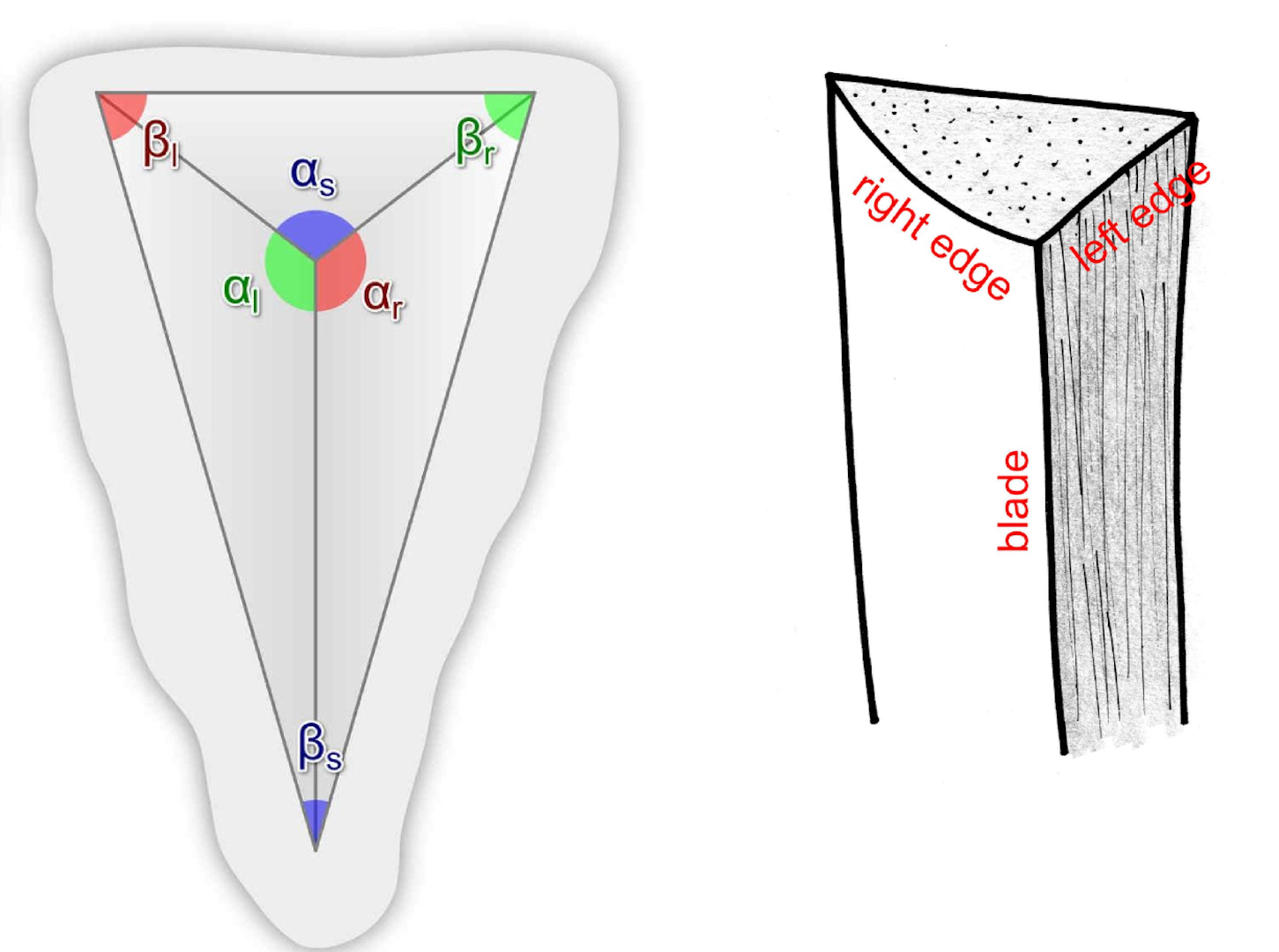
Fig. 2: The basic shape of wedge and stylus tip can be abstracted as tetrahedron and polyhedral cone respectively (after 3D-Joins und Schriftmetrologie).
When cuneiform writing was invented in ancient Sumer, the scribes scratched signs on the moist clay by means of a pointed instrument (fig. 1). Soon, however, they realized that it would be far more effective to impress marks using a squared-off tool. By doing so, they gave birth to the basic element of the cuneiform script: the ‘wedge’.
By appearance, wedges are tiny impressions of pyramidal shape – Thomas Hyde, one of the first Western scholars to provide an account of cuneiform script, described them in 1700 as “ductuli pyramidales seu cuneiformes”. The wedge can therefore be abstracted as a tetrahedron, and the stylus’ writing tip as a polyhedral cone (fig. 2).
The Reed Stylus
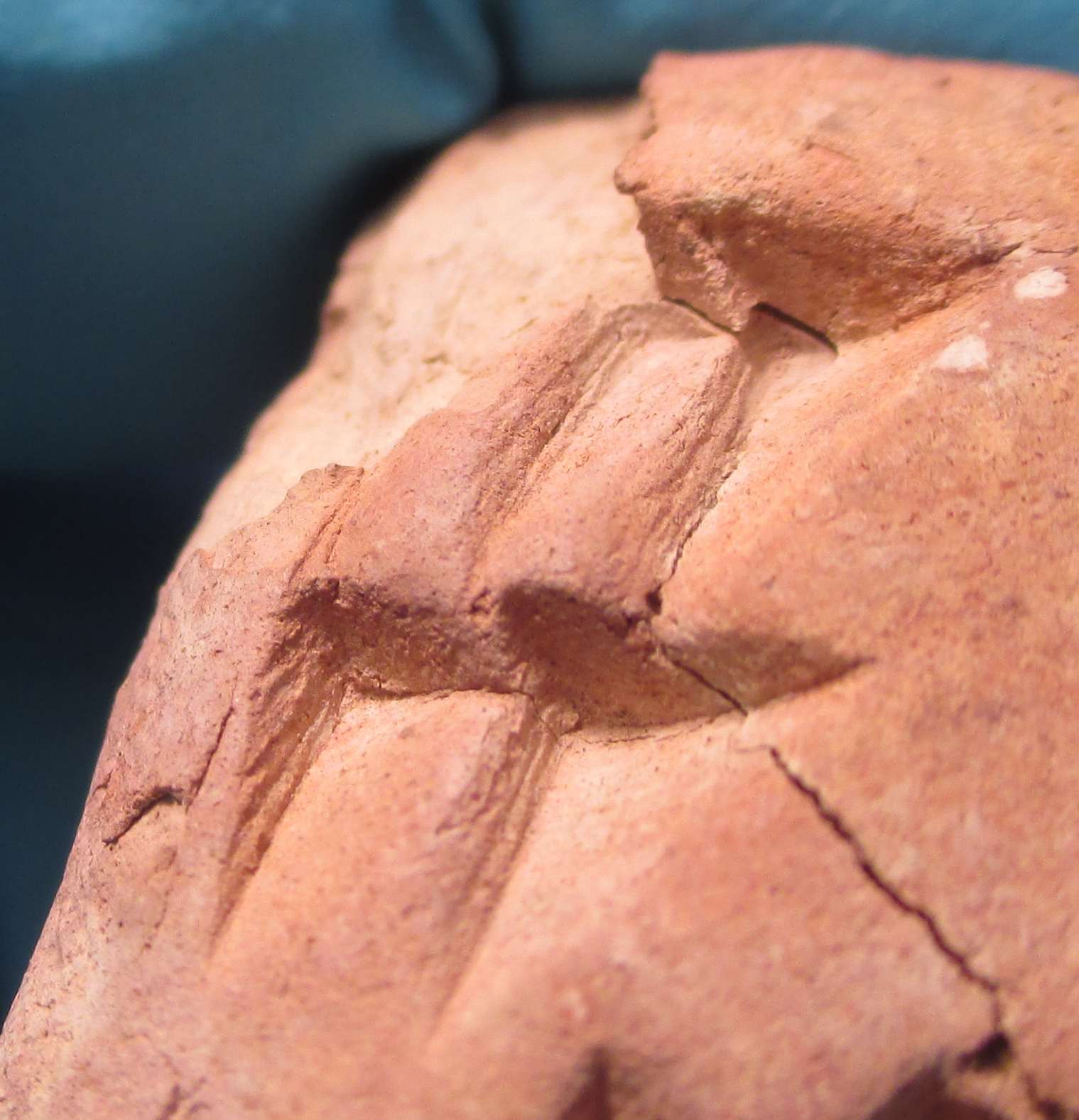
The Sumerian word for stylus, ‘tablet-reed’ (gi dub.ba, Akkadian qan tuppi), betrays the origin of the tool. Various species of reed were abundant in ancient Mesopotamia and Syria, and one of them, Arundo donax (giant reed), presents the optimal characteristics to serve as a writing tool. Split in an appropriate way, it provides a perfect stylus thanks to its ready availability, its solid stalk, and its glossy, waterproof skin (fig. 3).
Reed styli leave behind a characteristic pattern: the right-hand face of the wedge is smooth and slightly curved, whereas the left-hand face is flat and commonly displays fibrous impressions. The glossy outer skin of the reed prevents the stylus from sticking to the clay while being used, which is probably the reason why the curved part of the stylus was regularly used to impress the wider, right-hand face of the wedges (fig. 4).

Bone and Metal Styli
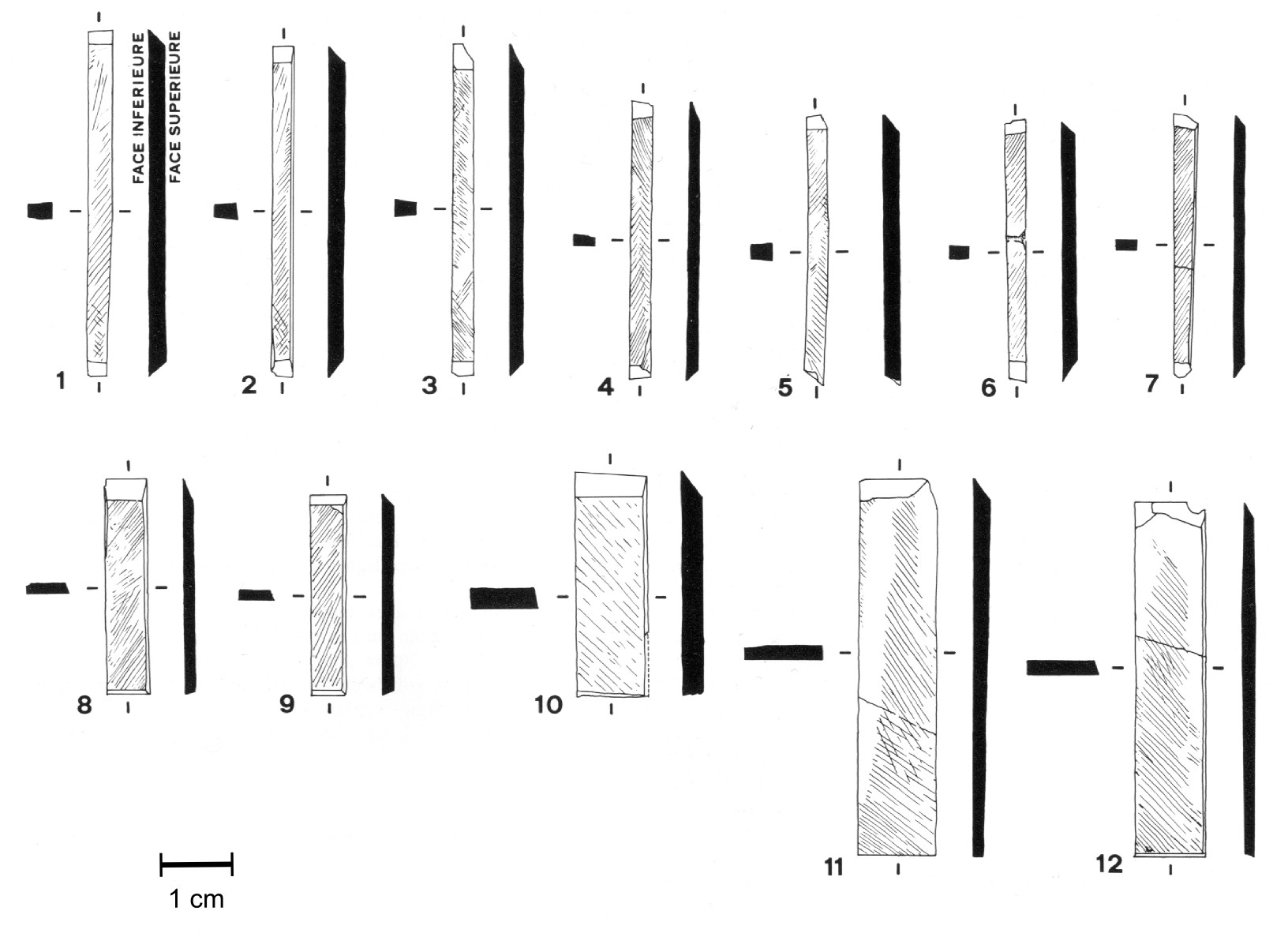
Although widely used in Mesopotamia down to the very end of the cuneiform age, reed was not the only material to be used. At the site of Tell ed-Dēr (Sippar-Amnanum), archeologists found twelve bone instruments which can be securely interpreted as writing styli. They look like short slats, bevelled at one or both ends, with right-angled or slightly sloped tips (fig. 5).
Furthermore, there is at least one entire scribal tradition which never made use of reed: in Hittite tablets, all wedge faces are smooth and flat, without any curvature or fibrous impressions. This fact points to the use of metal or bone styli, and indeed, the discover of Old Assyrian bone styli from the site of Kayalıpınar (Hittite Samuha) seems to corroborate this theory. That Hittite styli were not made of reed is also suggested by a letter in which the scribe Tarhunmiya, likely on expedition, asks his “beloved brother” in Tapikka to send him a new stylus since his own was “broken” or “lost”. In Mesopotamian corpora as well, the presence of the ‘reed pattern’ happens to be less frequent than traditionally assumed, a fact which points to a wider use of bone or metal styli.
Rulings were made either with the stylus or with slats or cords; the method used to create these rulings can be determined based on their appearance. Indeed, scribes must have at their disposal a variety of slats, brushes and cords to shape and smooth the tablets. Most impressions of oval, rectangular, trapezoidal, or triangular form, occasionally found on the manuscripts, originate from such tools; in a few cases, shape and dimensions are compatible with the assumption that they may correspond to the section of a stylus.
Stylus’ length and handling
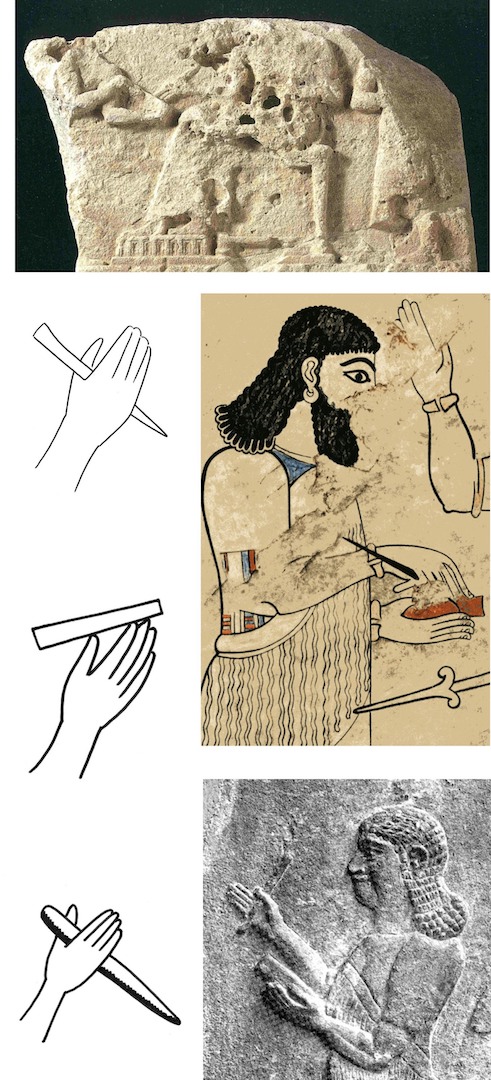
[After J. Marzahn – G. Schauerte, Babylon – Wahrheit, 2008, 338 Fig. 257; A. Parrot, Assur, 1961, 278 fig. 348; M. Cammarosano, The Cuneiform Stylus, 2014, 58 fig. 4]
The fact that both the styli from Tell ed-Dēr and those from Kayalıpınar are only a few centimeters long show that a stylus could be a very short device. This fits well with speculations of bio-mechanical nature on the way ancient scribes may have handled the stylus, and is corroborated by the depictions of styli as found in seals and Neo-Assyrian stelae; also, seemingly, by the peculiar appearance of rulings on some tablets. On the other hand, the average length of styli must not stay stable across different times and places, so the determination of ‘average’ stylus’ length(s) remains a very speculative issue.
Much is known about scribal curricula and apprenticeships, but very little about issues concerning writing technique: what was the posture of scribes when they worked? Where did they place big tablets while writing? And how fast could they write? Indeed, speed in writing was much appreciated in the ancient Near East, at least if we generalize the Sumerian proverb according to which “a scribe whose hand can keep up with the mouth, he is indeed a scribe!” Whereas sign forms evolved considerably in the course of time, the order in which scribes impressed the wedges within the various possible configurations was highly standardized, at least since the Old Babylonian period: recent studies by J. Taylor and A. Bramanti show that in Mesopotamia a fixed order of strokes existed for most signs from that time on, whereas more variability reigned during the Early Dynastic period, when the system was not yet fully established.
Depictions of scribes at work, mostly from Neo-Assyrian reliefs, show them standing in the act of recording booty. They hold the styli between thumb and all other fingers extended, while the tabet lays flat on the left hand. A stela possibly dating to the Ur III period and the well-known Assyrian mural painting from Til Barsip are the only know sources to show a scribe in the very act of writing on a clay tablet. In both cases, the scribe holds the stylus by handling its lower part with the hand in a half-supinate position. This fits well with the assumption that the supinate or half-supinate position would be advantageous for writing cuneiform, allowing the hand to pass more easily from horizontal to vertical wedges and vice versa (fig. 6).
The Sytlus of Nabu

The stylus was the symbol of Nabu, the god of scribal knowledge and writing; as such we find it represented in Babylonian kudurrus, Neo-Assyrian stelae and reliefs, and in countless seals from Mesopotamia and Syria.
Most times, the stylus alone is depicted; whereas grooved styli (for waxed boards) are normally depicted as double rods, cuneiform styli (for clay tablets) appear as tapered trapezoids, more rarely as triangles, with a right-angled or slanted tip.
In seals, however, the stylus enjoys a blooming, chamaleontic life, being often stylized as a hybrid between a stylus and a wedge, or even as a wedge tout court. Sometimes, Nabu himself is depicted on the seal, fiercely holding his divine, magically wedge-like stylus.

[After M. Cammarosano, The Cuneiform Stylus, 2014, 61 fig. 5 nos. 3, 5, 6, 7, 9, 12, 13, 26, 27]
Cuneiform on Wax
Waxed boards were extensively used in the ancient Near East, both for ephemeral records and for compositions intended for libraries and erudite collections. It has been calculated that at least one-third of Aššurbanipal’s library likely consisted of board-books. Attested in textual sources from the end of the 3rd millennium BC onwards, writing boards are archaeologically documented for the 2nd and 1st millennium BC: examples are known from the Ulu Burun shipwreck, Aššur, and Nimrud (fig. 8).

[Ulu-Burun writing board: photo © Institute of Nautical Archaeology; drawing after R. Payton, The Ulu Burun Writing-Board Set, AnSt 41, 1991, 105 fig. 4; Nimrud writing board: BM 131952, © Trustees of the British Museum]
The boards were made of wood or ivory, two or more leaves being hinged together to form diptychs, triptychs, or polyptychs. The sunken portion of each leaf accomodated a layer of beeswax mixed with other substances, primarily yellow ochre, which made the paste apt to be written on and gave it a yellowish colour.
On wax, both cuneiform and linear scripts like aramaic or hieroglyphs could be used. The existence of waxed boards inscribed in Luwian hieroglyphs in Hittite Anatolia is virtually assured by the discovery at Hattusa/Boğazköy of bronze styli with pointed tip and a spatula at the back end (fig. 9); Anatolian hieroglyphs continued to be used on waxed boards in Iron Age Syria (fig. 10). On the other hand, two of the Neo-Assyrian writing boards from Nimrud still preserve a portion of the wax layer inscribed with cuneiform signs (fig. 11).
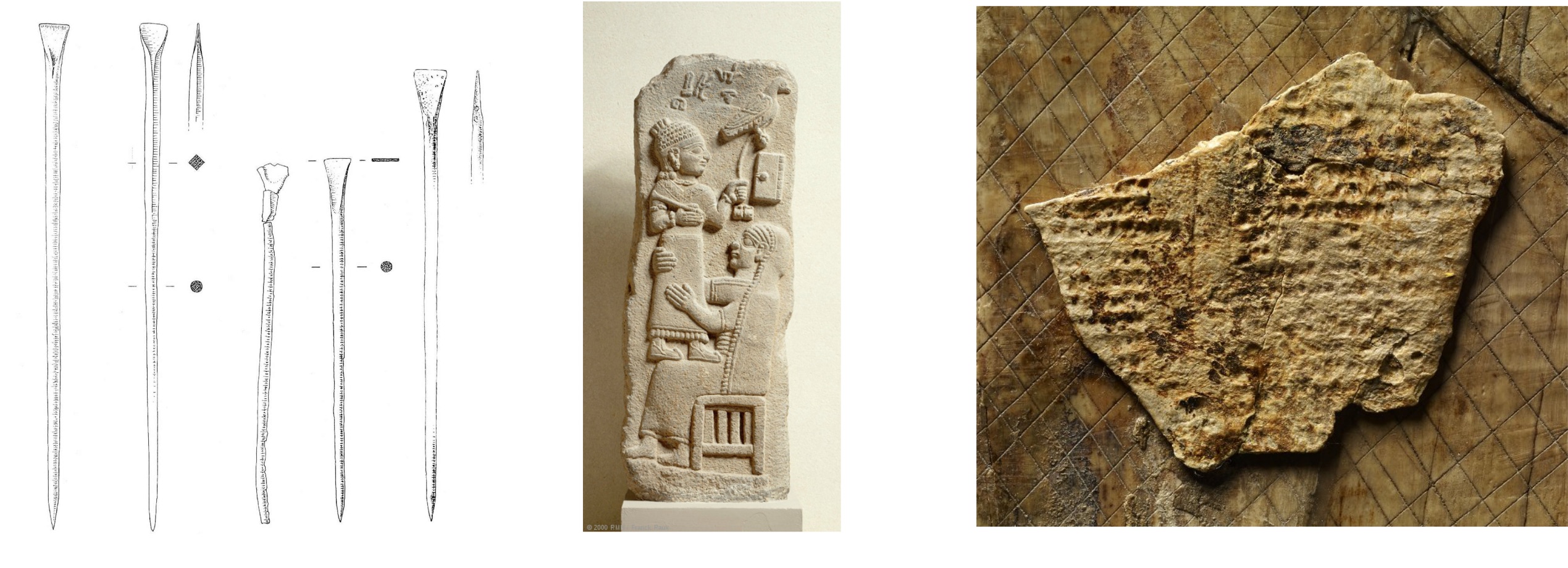
Fig. 10: The funerary stela of the augur Tarhunpiya, with folded writing board and stylus (note the spatula at its bottom end), from Maras, 8th century BC. [AO 19222, © 2011 Musée du Louvre/RMN Franck Raux]
Fig. 11: Detail of the wax layer of one ivory writing board from Nimrud, still preserving a part of the astronomical omen series Enuma Anu Enlil inscribed in cuneiform script. [BM 131952, © Trustees of the British Museum]
Cuneiform styli used for waxed boards seem to have been immersed in a special fat, probably serving as release agent to prevent the wax paste bonding to the stylus: in a letter to the Assyrian king Aššurbanipal, Babylonian scholars refer to “[ ... ] syrup, ghee and pressed (oil) for the kettle of their styli, to soak (them into it)”. Furthermore, styli connected with writing boards, as depicted on seals and reliefs, display two peculiarities as compared to those used for clay tablets: scribes with board-books are regularly shown holding the stylus with index and middle fingers extended; moreover, their styli show a groove on one side (fig. 12). Which purpose did the groove serve? The issue is being presently investigated in the interdisciplinary research project Cuneiform on Wax at the JMU Würzburg. Several options are open, the most intriguing one being the view that the groove might allow the wedges to be painted with a pigment while being impressed.

[Left to right: BM 124955, © Trustees of the British Museum, after J. Reade, Assyrian Scultpure, 1983, 33; Burrell Collection, Glasgow, 28.33, after Barnett et al., Sculptures from the Southwest Palace of Sennacherib at Nineveh, London 1998, 84 Pl. 222; Nahr-al-Kalb relief of Esarhaddon, after VS 1 Beiheft, Pl. 8; BKR 96]
Not its cup of tea: Cuneiform on hard materials
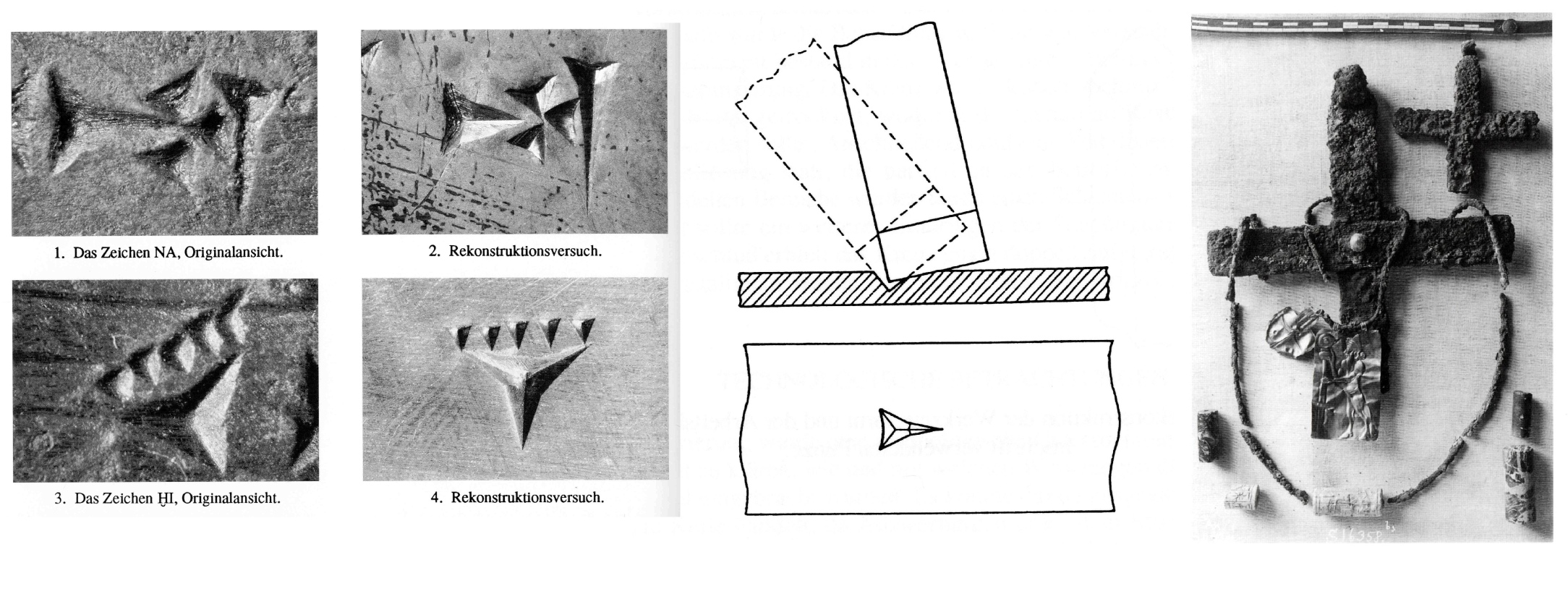
Although cuneiform script had been originally designed for clay tablets, in the course of the centuries it was also used on metal, stone, and other hard materials. In these cases, the wedges had to be carved, scratched, painted, or impressed through techniques other than the ones used for clay or wax. As a consequence, the shape of these wedges differs substantially from that of the ‘canonical’ ones, even in those cases when signs retain a three-dimensional form.
On the Middle Assyrian bronze cross VA 5379, the wedges were obtained by beating an iron punch on the bronze surface, as reconstructed by G. Jendritzki at the Vorderasiatisches Museum in Berlin. The wedge was shaped through multiple blows: a first blow produced the wedge’s ‘head’, the following ones the ‘tail’ (fig. 13).
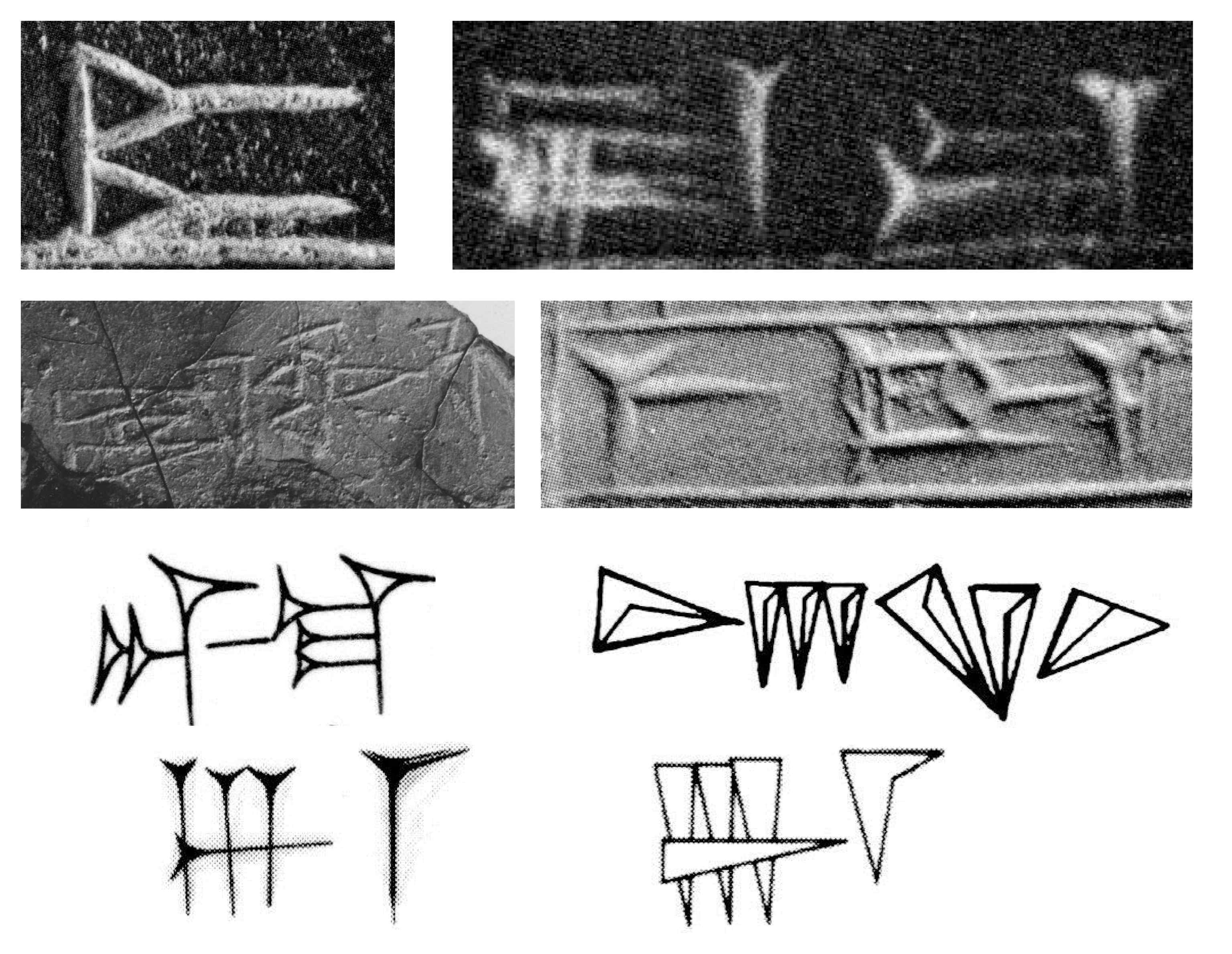
[credits in E. Devecchi et al. (eds.), Current Research in Cuneiform Paleography, 2015, 147 fig. 1]
A different technique was used for the Hittite Bronze Tablet from the time of Tudhaliya IV, where the wedges do not display sharp angles, and still other methods were used to carve wedges on stone, for inscriptions or seals. Cuneiform signs could also be painted with ink, scratched, or cut onto hard materials. A wide variety of strategies are applied to convey the three-dimensional geometry of the wedges in a basically two-dimensional frame: whereas some single out the inner edges, some others prefer the outer ones, and still others opt for a stylized adaptation, up to the Mittellinien used in most line drawings of our times (fig. 14). The extent to which an adapted, cuneiform-like script was used on wooden tablets remains uncertain, particularly in consideration of the fact that terminological distinctions between different types of writing boards are opaque to us. Thus, it is not unconceivable that a number of references to wooden writing boards actually refer to tablets on which the signs, whether cuneiform or not, were inked directly on wood rather than impressed on a wax layer.
On the wedge’s edge: Wedge analysis and quantitative palaeography
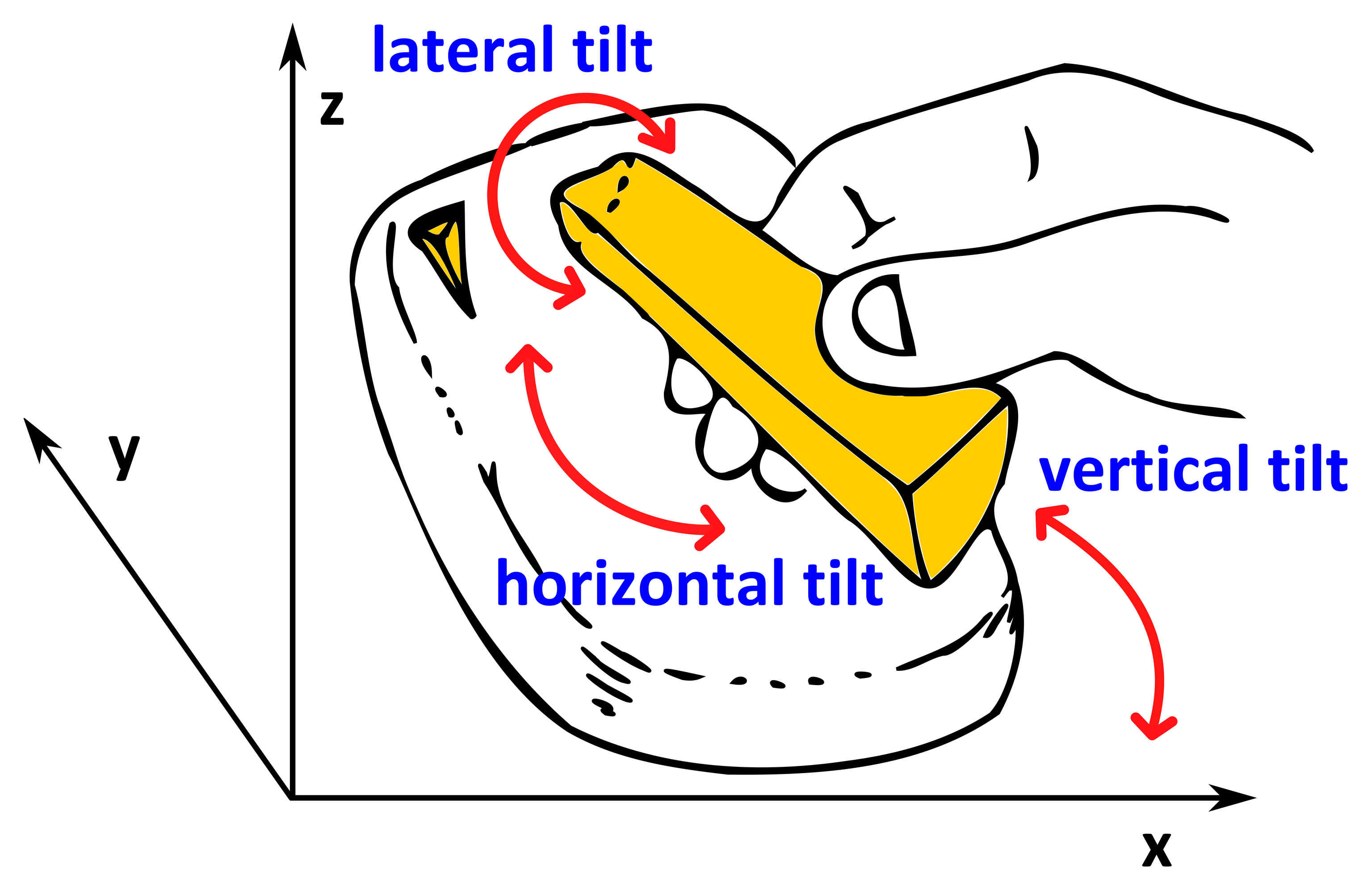
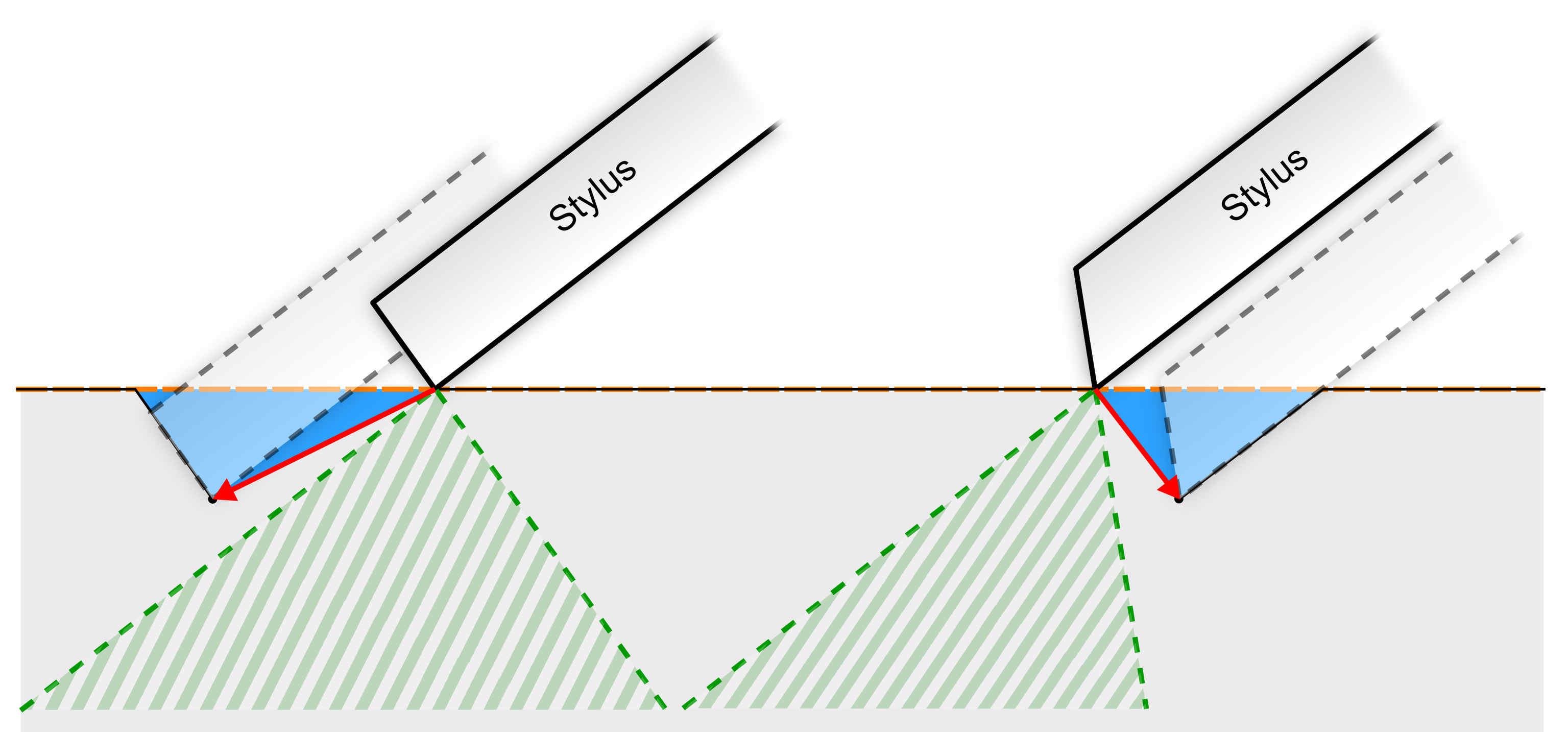
Since almost no examples of a stylus have survived, writing techniques are best investigated through the traces styli left behind on the tablets, i.e. through the evidence of the wedges. Today, 3D digitizing and computer-aided image processing provide the possibility of precise measurements of the wedges’ geometrical properties, thus opening up new perspectives in palaeographical studies.
Based on the factors which determine the relationship between the writing tip and the wedge impression, the geometrical configuration of the stylus’ tip can be predicated based on the interaction of the stylus’ edges and its trajectory during the impression. This means that, depending on the way they have been cut, certain styli will tend to produce wedges with stable inner angles, whereas others will not. A statistical analysis of the geometrical properties of the wedges and of their behaviour across different wedge types is therefore able to characterize the handwriting of a specific tablet, scribe, or script: this is the domain of quantitative palaeography and script metrology, a field with crucial implications for the identification of joins, the attribution of tablets, and the synchronic/diacronic differentiation of scripts (fig. 15).
Try yourself!
Writing cuneiform is much easier than you may think… and it’s fun!
To learn how to write exquisite cuneiform, visit the parent page How to Write Cuneiform
Further readings
- L. Messerschmidt, “Zur Technik des Tontafel-Schreibens”, OLZ 9, 1906, 185-196, 304-312, 372-380
- M. Cammarosano, “The Cuneiform Stylus”, Mesopotamia XLIX, 2014, 53-90
- A. Bramanti, “The Cuneiform Stylus. Some Addenda”, CDLN 2015/12
- E. Devecchi, G. Müller, and J. Mynářová (eds.), Current Research in Cuneiform Palaeography, Gladbeck 2015
- Cuneiform on Wax project webpage, JMU Würzburg